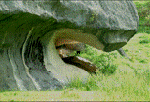Living World
 Water and Wetlands
Water and Wetlands
Lifecycles and identifying specimens, native and introduced fish in the field, finding invertebrates. Water the precious resource and its use through time. Riparian strip plants. the water cycle, early access to water: wells, bores, irrigation, floods, hydroelectric and farming/industry impacts.
Conceptual ideas could include: testing ideas, sustainability, resources.
Sea and shore
Kai Moana, birds, fish, shells, plants and more, life cycles, finding and identifying specimens.
Conceptual ideas could include: Life processes.
 Forest environment
Forest environment
Birds, Native freshwater fish, insects, plants and more, life cycles, habitats, finding and identifying specimens. Impact of changes from farming, forestry and sustainability. Find and identify invertebrates.
Conceptual ideas could include: testing ideas sustainability, resources.
 NEW: Check out Insects & Spiders - a range of resources and suggestions for teachers and educators supporting online learning through our new Heritage@Home service
NEW: Check out Insects & Spiders - a range of resources and suggestions for teachers and educators supporting online learning through our new Heritage@Home service
Planet Earth and Beyond
Matariki
Understand the astronomy of some common constellations. Relate Maori celebration of the new year to astronomical time. The importance of whenua (land), rangi and whetu (sky and stars) for story telling, teaching, learning values, and celebrations.
Conceptual ideas could include: Celebrations.
 Rocks in the neighbourhood
Rocks in the neighbourhood
The rock cycle, basic geology, plate tectonics, and New Zealand's formation, classify specimens into three rock types. Find out about our youngest and oldest rocks. Observe fossils and formations in the field. Find out where our local volcanoes are.
Conceptual ideas could include: Interconnecting systems, Earth below.
Physical World
Lighting the world
Candles, lanterns, torches, gaslight and the history of local lighthouses. Changing fuel
sources. Photographers using light to capture history.
Conceptual ideas could include: Transformation, Energy to burn.